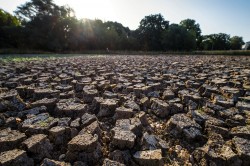press release, 25. September 2023
Heat extremes in the soil are underestimated
Climate change intensifies extreme heat in the soil
For a long time, little attention was paid to soil temperatures. In contrast to air temperatures near the surface, hardly any reliable data was available because of the considerably more complex measurement. A research team leaded by the Helmholtz Centre for Environmental Research (UFZ) has now found not only that soil and air temperatures can differ but also that climate change has a much greater impact on the intensity and frequency of heat extremes in the soil than in the air. According to a study recently published in Nature Climate Change, this is particularly the case in Central Europe.
For the study, the research team coordinated by UFZ remote sensing scientist Dr Almudena García-García collected data from a wide range of sources: data from meteorological measuring stations, remote sensing satellites, the ERA5-Land data reanalysis set, and simulations of Earth system models. The researchers fed these data into the TX7d index, which is defined as the average of the daily maximum temperature in the hottest week of the year. It reflects the intensity of heat extremes (i.e. how high extreme temperatures can be). The researchers thus calculated the index for the 10-cm-thick upper soil layer and for the near-surface air at a height of up to 2 m for the years 1996 to 2021. At two thirds of the 118 meteorological measuring stations evaluated, the trend in heat extremes is stronger in the soil than in the air. "This means that heat extremes develop much faster in the soil than in the air", García-García, lead author of the study. Based on the data available, this is especially true in Germany, Italy, and southern France. In terms of figures, according to station data, the intensity of heat extremes in Central Europe is increasing 0.7°C/decade faster in the soil than in the air.
The research team examined not only the intensity but also the frequency of heat extremes in the soil. In order to calculate this, the scientists used the TX90p index, which takes into account the percentage of days per month when the daily maximum temperature was higher than the statistical limit between 1996 and 2021. According to the calculations, the number of days with heat extremes is increasing twice as fast in the soil as in the air. "For example, if there are currently high temperatures in the soil and air on 10% of the days in a month, a decade later, there will be high temperatures in the air on 15% of the days and high temperatures in the soil on 20%", says García-García. The decisive factor here is soil moisture, which plays an important thermal role in the exchange between air and soil. Soil moisture is strongly dependent on land cover. For example, in forests, trees can draw water from deeper in the soil with their roots and reduce losses through evaporation in summer. On the other hand, agricultural crops or grasslands can only access water from soil near the surface.
The fact that extreme temperatures can develop quickly in the soil and differ considerably from those in the air layer near the soil has important consequences. If the temperature of the soil is higher than that of the air, additional heat is released into the lower atmosphere, thereby causing atmospheric temperatures to rise. "Soil temperature acts as a factor in the feedback between soil moisture and temperature and can thus intensify heat periods in certain regions", explains Dr Jian Peng, co-author and head of the UFZ Remote Sensing Department. This feedback has an influence on many hydrological processes that are important for agriculture (and thus for food security), on ecosystems (because temperature-tolerant species could be favoured), and on the storage of terrestrial carbon. "In view of these results, studies on the effects of heat extremes, which consider mainly air temperatures but have underestimated the factor of heat extremes in the soil, would have to be re-evaluated", he says.
The research team also used data from Earth system models in order to investigate how frequently extreme soil temperatures could amplify heat waves in the atmosphere - depending on the expected global climate scenario. They found that if the 2 degree or 3 degree scenario occurs, this will have a much greater impact on Central Europe than a 1.5 degree warming. For example, there could be 8% more hot days on which the soil releases heat into the atmosphere. "This would, in turn, intensify the periods of hot weather in the air", says García-García. It can therefore be assumed that soils will play an increasingly important role in the development of heat extremes.
Publication:
Almudena García-García, Francisco José Cuesta-Valero, Diego G. Miralles, Miguel D. Mahecha, Johannes Quaas, Markus Reichstein, Jakob Zscheischler and Jian Peng. Soil heat extremes can outpace air temperature extremes, Nature Climate Change, doi: 10.1038/s41558-023-01812-3
https://www.nature.com/articles/s41558-023-01812-3
Further information
Prof. Dr. Jian Peng
Head of the UFZ Department of Remote Sensing
jian.peng@ufz.de
Dr. Almudena García-García
UFZ Department of Remote Sensing
almudena.garcia-garcia@ufz.de
UFZ press office
Susanne Hufe
Phone: +49 341 235-1630
presse@ufz.de
In the Helmholtz Centre for Environmental Research (UFZ), scientists conduct research into the causes and consequences of far-reaching environmental changes. Their areas of study cover water resources, ecosystems of the future, environmental technologies and biotechnologies, the effects of chemicals in the environment, modelling and social-scientific issues. The UFZ employs more than 1,100 staff at its sites in Leipzig, Halle and Magdeburg. It is funded by the Federal Government, Saxony and Saxony-Anhalt.
www.ufz.deThe Helmholtz Association contributes to solving major challenges facing society, science and the economy with top scientific achievements in six research fields: Energy; Earth and Environment; Health; Key Technologies; Matter; and Aeronautics, Space and Transport. With some 39,000 employees in 19 research centres, the Helmholtz Association is Germany’s largest scientific organisation.
www.helmholtz.de
